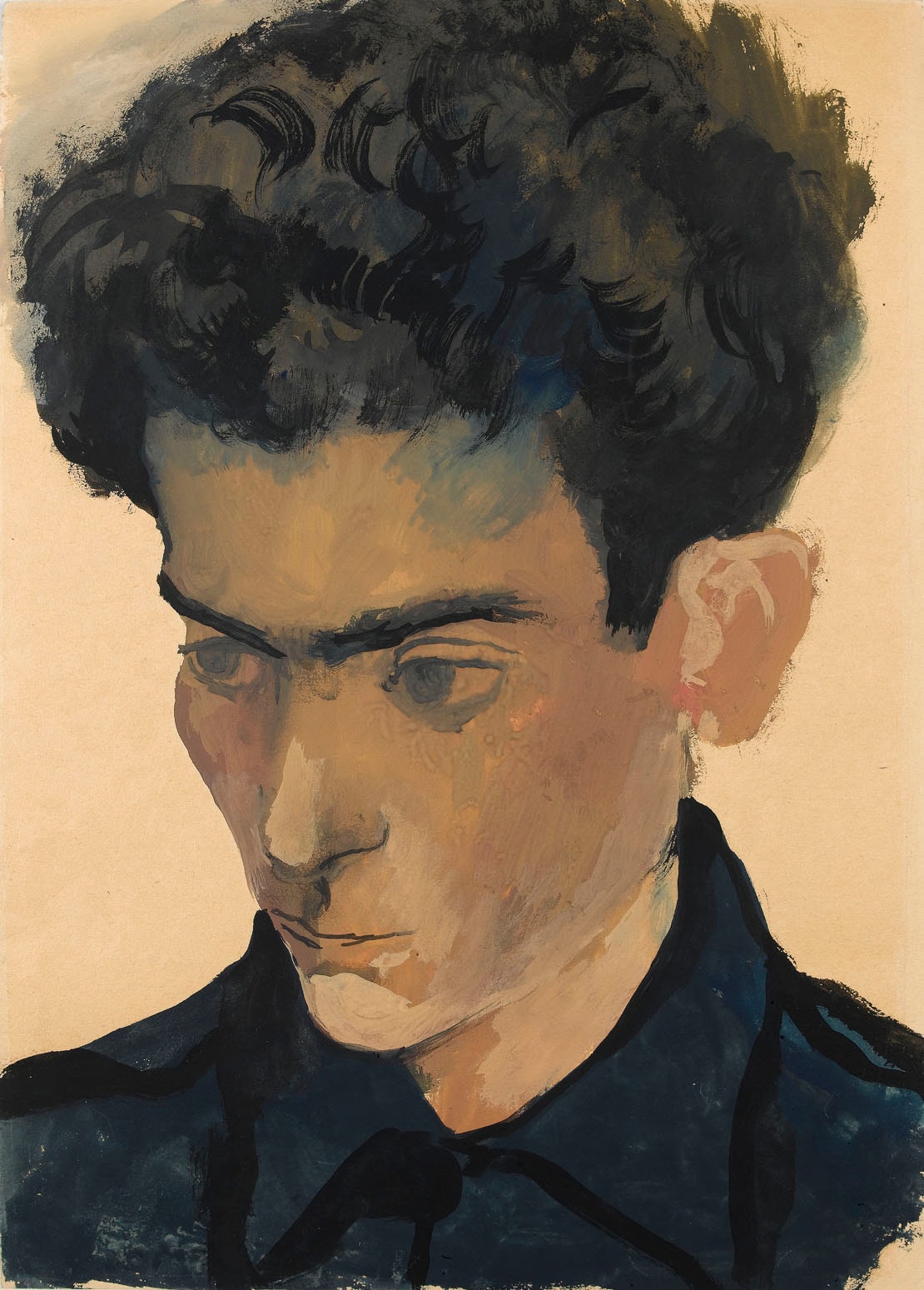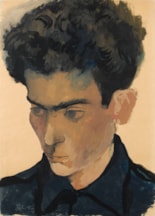Pavel TCHELITCHEV
(Kaluga 1898 - Rome 1957)
Portrait of a Young Man
Sold
Brush and black ink, gouache and watercolour on light brown paper.
Stamped with the artist’s signature P. Tchelitchew on the verso.
353 x 250 mm. (13 7/8 x 9 7/8 in.)
Stamped with the artist’s signature P. Tchelitchew on the verso.
353 x 250 mm. (13 7/8 x 9 7/8 in.)
The present sheet may be dated to around 1927, while Tchelitchev was living and working in Paris. The 1920’s were a period of intense interest in portraiture on the part of the young artist, and it was during this period that, as one early scholar has noted, ‘the human face began to fascinate him above all other subjects. In late 1924 and 1925 he finished several self-portraits and a number of portraits of friends with whom his psychological and emotional accord was intimate and continuous…In [these portraits] are the unmistakable signs of the expressionist tradition of portraiture which had been developing in Europe since the turn of the century…But within the hard, arbitrary contours of Tchelitchew’s portraits there is an implication of tender brooding and reverie which the portraiture of his elders for the most part lacked. By comparison with the latter, Tchelitchew’s portraits are romantic or, as the term came to be, Neo-Romantic.’
This drawing – which remained with Tchelitchev until his death – would appear to depict the American pianist Allen Tanner (1898-1987), a friend and companion of the painter during his years in Berlin and Paris. As Tchelitchev’s posthumous biographer has noted of Tanner, ‘An aspiring pianist in those old days, he had been a gilded willowy youth with a shock of black hair, a soft, half-hidden, languishing glance, a handsome face and the primmest lips and largest romantic ideas in the world.’ Tanner was first introduced to Tchelitchev in Berlin in December 1922, and the two soon became lovers, sharing an apartment and moving to Paris together in 1923. The relationship continued until 1933, when Tchelitchev began a liaison with another American, the writer and poet Charles Henri Ford.
This drawing – which remained with Tchelitchev until his death – would appear to depict the American pianist Allen Tanner (1898-1987), a friend and companion of the painter during his years in Berlin and Paris. As Tchelitchev’s posthumous biographer has noted of Tanner, ‘An aspiring pianist in those old days, he had been a gilded willowy youth with a shock of black hair, a soft, half-hidden, languishing glance, a handsome face and the primmest lips and largest romantic ideas in the world.’ Tanner was first introduced to Tchelitchev in Berlin in December 1922, and the two soon became lovers, sharing an apartment and moving to Paris together in 1923. The relationship continued until 1933, when Tchelitchev began a liaison with another American, the writer and poet Charles Henri Ford.
Born into an aristocratic family in Moscow, Pavel Feodorovitch Tchelitchev (or Tchelitchew) was educated by private tutors. In 1918 his family fled Moscow during the Bolshevik Revolution, settling in Kiev, where Tchelitchev attended drawing classes at the Kiev Academy. There he met and was encouraged by the set designer Alexandra Exter, and worked on stage sets and poster designs. Working in Berlin in the early 1920’s, Tchelitchev achieved a fair amount of success as a stage designer, designing the sets and costumes for productions such as Rimsky-Korsakov’s Coq d’Or, and also began painting portraits and still-lives. He came to the attention of the ballet impresario Sergei Diaghilev, who encouraged the young artist to come to Paris, where he settled in 1923. As well as exhibiting at the Salon d’Automne, Tchelitchev was included in a group exhibition at the Galerie Druet in 1926, alongside Eugène Berman, Christian Bérard and other artists who painted in a distinctive, dreamlike manner known as Neo-Humanism or Neo-Romanticism.
Tchelitchev was given his first one-man exhibition at the Claridge Gallery in London in 1928, and the same year designed the costumes and sets for Diaghilev’s Ode. In 1934 Tchelitchev settled in New York, where his fantastical paintings of allegorical subjects gained considerable him attention. A one-man show at the Julien Levy Gallery in 1938 was followed four years later by an exhibition at the Museum of Modern Art, which acquired one of his best-known allegorical works, Hide and Seek, painted between 1940 and 1942. Tchelitchev’s works were collected by such prominent cultural figures as Gertrude Stein, Edith Sitwell (who described the artist as ‘tragic, haunted, and noble…one of the most generous human beings I have ever known’), Sir Kenneth Clark and Lincoln Kirstein, who published an early monograph on the artist’s drawings. From 1949 onwards Tchelitchev lived mainly in Rome, where he died in 1957, at the age of fifty-nine.
Dame Edith Sitwell, who owned nearly forty drawings by the artist, praised Tchelitchev as ‘a transcendentally great draughtsman’, while his friend Lincoln Kirstein described him as ‘one of the most varied and memorable portraitists of his epoch.’
Provenance
The estate of the artist
Richard Nathanson, London, in 1972
Richard Addinsell, London
His posthumous sale, London, Sotheby’s, 28 June 1978, lot 182
Private collection, Hamburg.
Exhibition
London, Richard Nathanson at The Alpine Club, Pavel Tchelitchew: A Selection of Paintings, Gouaches and Drawings, 1972, no.8 (as Boy in a Blue Shirt).




